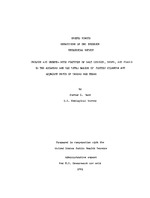Geology and ground-water features of salt springs, seeps, and plains in the Arkansas and Red River basins of western Oklahoma and adjacent parts of Kansas and Texas
Links
- Document: Report (pdf)
- Plates:
- NGMDB Index Page: National Geologic Map Database Index Page (html)
- Download citation as: RIS | Dublin Core
Abstract
The salt springs, seeps, and plains described in this report are in the Arkansas and Red River basins in western Oklahoma and adjacent areas in Kansas and Texas. The springs and seeps contribute significantly to the generally poor water quality of the rivers by bringing salt (NaCl) to the surface at an estimated daily rate of more than 8,000 tons. The region investigated is characterized by low hills and rolling plains. Many of the rivers are eroded 100 feet or more below the .surrounding upland surface and in places the valleys are bordered by steep bluffs. The alluvial plains of the major rivers are wide and the river channels are shallow and unstable. The flow of many surface streams is intermittent, especially in the western part of the area. All the natural salt-contributing areas studied are within the outcrop area of rocks of Permian age. The Permian rocks, commonly termed red beds, are composed principally of red and gray gypsiferous shale, siltstone, sandstone, gypsum, anhydrite, and dolomite. Many of the formations contain halite in the subsurface. The halite occurs mostly as discontinuous lenses in shale, although some of the thicker, more massive beds are extensive. It underlies the entire region studied at depths ranging from about 30 feet to more than 2,000 feet. The salt and associated strata show evidence of extensive removal of salt through solution by ground water. Although the salt generally occurs in relatively impervious shale small joints and fractures ,allow the passage of small quantities of water which dissolves the salt. Salt water occurs in the report area at depths ranging from less than 100 feet to more than 1,000 feet. Salt water occurs both as meteoric and connate, but the water emerging as salt springs is meteoric. Tritium analyses show that the age of the water from several springs is less than 20 years. The salt springs, seeps, and plains are confined to 13 local areas. The flow of the springs and seeps is small, but the chloride concentration in the water ranges from a few hundred parts per million to about 190,000 ppm. The wide range of concentration is believed to be due, in part, to differential dilution by fresh water. Alluvium in the vicinity of the salt springs remains saturated with salt water and evaporation from the alluvial surface causes the formation of a salt crust during dry weather. Those areas appear as salt plains that range in size from less than an acre to as much as 60 square miles. The rocks exposed at the surface in the vicinity of the salt springs are permeable enough to allow the infiltration of some precipitation. Under certain geologic and hydrologic conditions ground water percolates down and through salt-bearing rocks where it dissolves the salt. Hydrostatic pressure of ground water at higher elevations forces the salt water to emerge as salt springs at lower elevations.
Study Area
| Publication type | Report |
|---|---|
| Publication Subtype | USGS Numbered Series |
| Title | Geology and ground-water features of salt springs, seeps, and plains in the Arkansas and Red River basins of western Oklahoma and adjacent parts of Kansas and Texas |
| Series title | Open-File Report |
| Series number | 63-132 |
| DOI | 10.3133/ofr63132 |
| Year Published | 1963 |
| Language | English |
| Publisher | U.S. Geological Survey |
| Description | Report: 94 p., 7 Plates: 39.49 × 62.40 inches or smaller |
| Country | United States |
| State | Kansas, Oklahoma, Texas |
| Other Geospatial | Arkansas and Red River basins |


